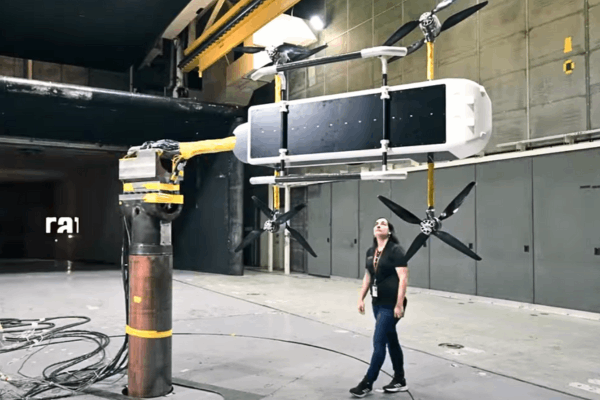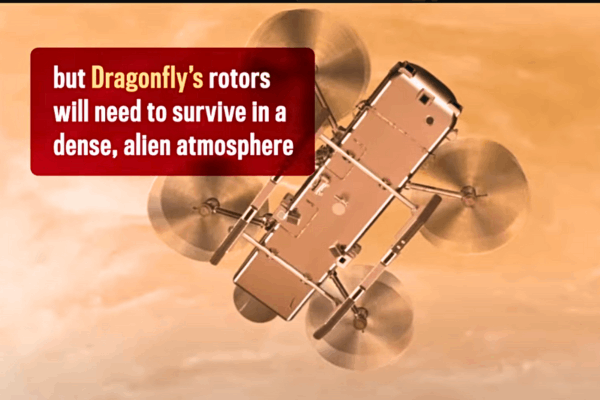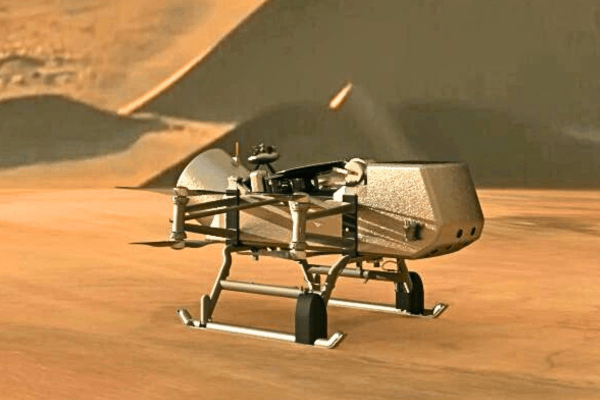NASA is exploring the unknown, undertaking an unprecedented journey to Titan, which happens to be Saturn’s biggest moon in pursuit of a new frontier in space exploration. The mission for this mystery moon has been christened “Dragonfly”, and through the successful execution of this mission; it is envisioned that this moon will shed many unknown aspects about itself. This trip blends fiction and facts of science.
The Dragonfly Mission: A Fusion of Tech and Ambition
To be launched next year 2027, and for titan target in 2034, Dragonfly is NASA’s idea. The mission’s ambition is unmatched. Dragonfly becomes the first rotocraft to visit a planetary moon and pioneer nuclear power for outer planet exploration.
Titan, Saturn’s moon, beckons as the destination. Boasting a thick, Earth-like atmosphere, it’s a tantalizing world for scientists. Titan’s unique properties could hold the key to unlocking secrets about our own origins and the potential for life beyond Earth.
The Quest for Prebiotic Chemistry: The Building Blocks of Life
One of the primary objectives of the Dragonfly mission is to delve into Titan’s prebiotic chemistry. Prebiotic Chemistry forms the foundation for life, encompassing the chemical processes that pave the way for life to emerge. Titan’s allure lies in its thick atmosphere teeming with organic molecules and the presence of lakes and rivers filled not with water but liquid methane and ethane. This tantalizing cocktail of chemicals could offer insights into how life on Earth might have sprung into existence.
The Search for Life on Titan: Liquid Water and Unanswered Questions
Dragonfly’s quest doesn’t stop at chemistry. Another paramount objective is to seek signs of past or even current life on Titan. The tantalizing possibility of life has scientists eager to explore this celestial body because it harbors liquid water beneath its surface. This precious ingredient is fundamental for life as we know it, and Titan’s hidden oceans could very well be teeming with secrets waiting to be unveiled.
The Remarkable Dragonfly Drone: A Marvel of Engineering
Dragonfly takes the form of a quadcopter drone, a high-tech marvel with a nominal mass ranging from 400 to 450 kilograms. Roughly the size of the largest Mars rovers, it defies the traditional image of a space probe. With its eight rotors neatly arranged in four pairs on outriggers, Dragonfly is designed for agility and exploration. It can achieve a speed of about 10 meters per second and reach altitudes of up to 4000 meters.

Similar to Earthly drones, Dragonfly can navigate between multiple locations on Titan, exploring the moon’s potential habitability and seeking evidence of life. The very idea of a drone soaring through another world’s thick atmosphere is a testament to human ingenuity and scientific curiosity.
Why Titan? Titan’s Enigmatic Atmosphere
Therefore, why does Titan stand out as a prospective location of investigation? This is the only moon in our solar system with four times thicker atmosphere as compared to our own Earth’s atmosphere. The moon is an extraordinary site for exploring a world which is similar to early days of Earth.

Titan’s nitrogen-rich atmosphere, coupled with a treasure trove of complex organic materials, presents a compelling mystery. How do these materials interact with Titan’s environment, including the potential for past interactions with liquid water beneath its icy surface? Dragonfly is poised to uncover the answers.
Testing the Limits: Crucial Trials for Dragonfly
Before embarking on its interstellar journey, Dragonfly faces an earthly challenge. How can it endure Titan’s peculiar environment? To ensure its readiness, the Dragonfly team has undertaken rigorous testing at NASA’s Langley Research Center in Hampton, Virginia.
In a mesmerizing display of engineering ingenuity, Dragonfly’s four dual-coaxial rotors were put through their paces in a wind tunnel. But not just any wind tunnel – this one simulates the atmospheric conditions found on Saturn’s largest moon. Four campaigns of testing, including those in a 14-by-22 foot subsonic tunnel and a 16-foot Transonic Dynamics Tunnel (TDT), have rigorously validated the craft’s performance under conditions it is likely to encounter on Titan.
This recent testing, conducted in June, involved a half-scale Dragonfly model and yielded an abundance of data. The analysis of this wealth of information is a collaborative effort involving experts from various institutions. Their combined expertise ensures that Dragonfly’s rotor performance will be reliable in Titan’s unique atmosphere.
Conclusion
As the Dragonfly mission takes shape, it’s becoming increasingly clear that this is no ordinary exploration. It’s an ambitious quest to peer into the very origins of life, a mission that fuses cutting-edge technology with scientific curiosity. The Dragonfly team, guided by this vision, is poised to reshape our understanding of our own existence and the possibilities that await us in the Cosmos.
In 2027, the skies above Titan will be graced by the fluttering wings of Dragonfly. It’s a dance of Science and imagination, where each step unveils a new page in the cosmic storybook of our universe.




